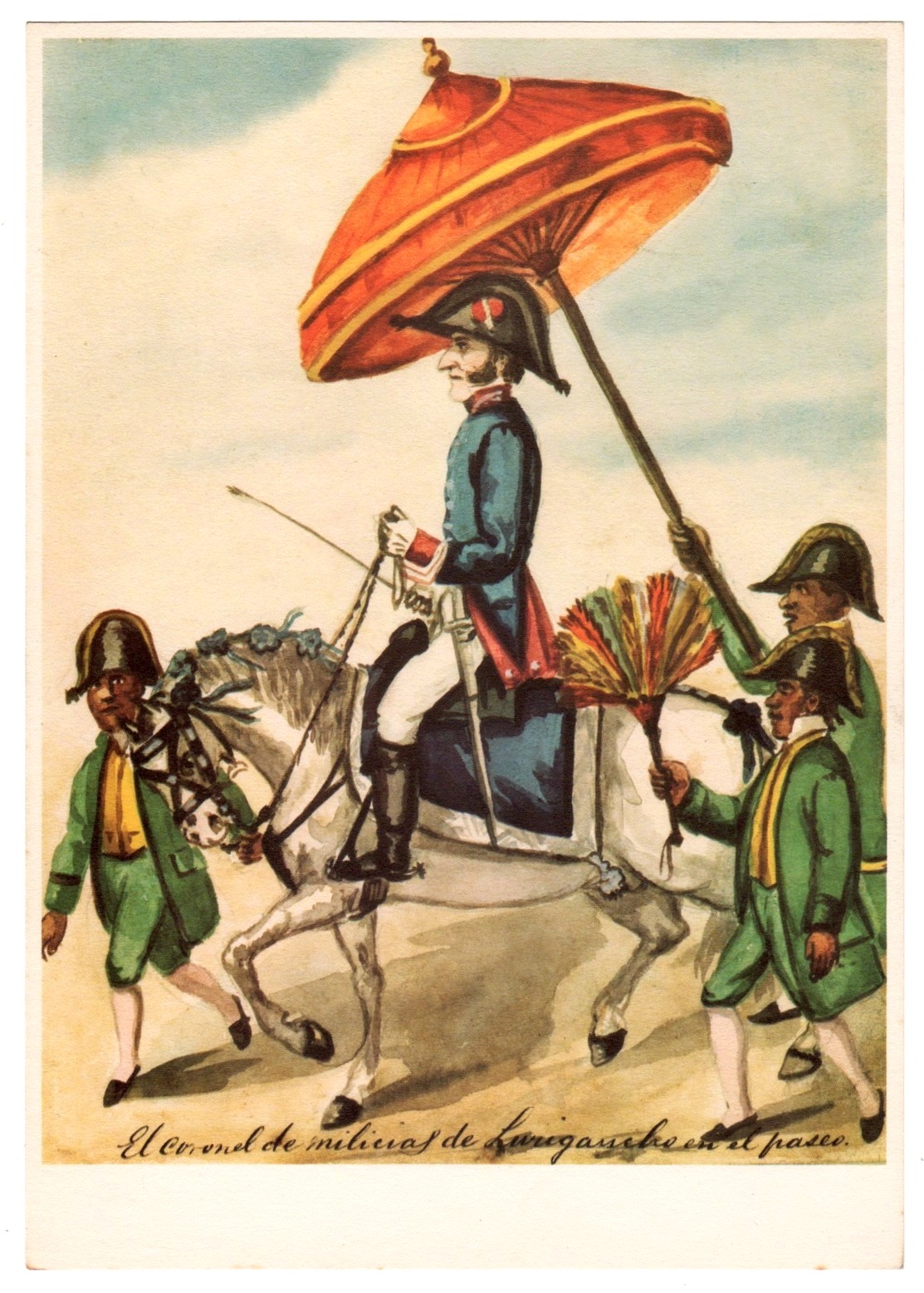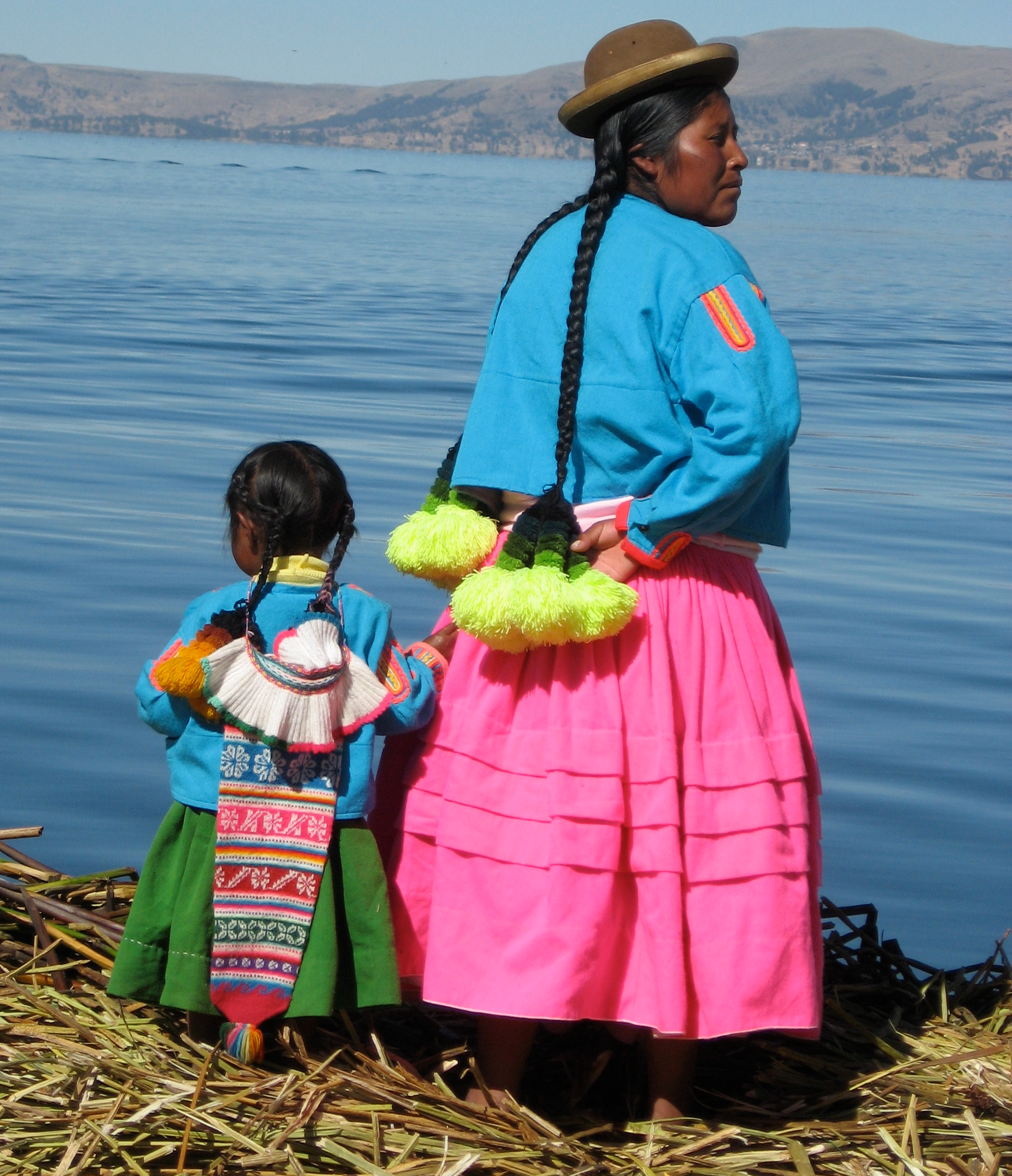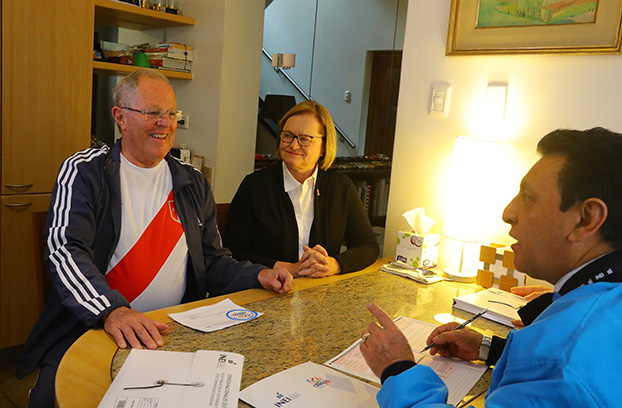|
Peru
Peru, officially the Republic of Peru, is a country in western South America. It is bordered in the north by Ecuador and Colombia, in the east by Brazil, in the southeast by Bolivia, in the south by Chile, and in the south and west by the Pacific Ocean. Peru is a Megadiverse countries, megadiverse country, with habitats ranging from the arid plains of the Pacific coastal region in the west, to the peaks of the Andes mountains extending from the north to the southeast of the country, to the tropical Amazon basin rainforest in the east with the Amazon River. Peru has Demographics of Peru, a population of over 32 million, and its capital and largest city is Lima. At , Peru is the List of countries and dependencies by area, 19th largest country in the world, and the List of South American countries by area, third largest in South America. Pre-Columbian Peru, Peruvian territory was home to Andean civilizations, several cultures during the ancient and medieval periods, and has one o ... [...More Info...] [...Related Items...] OR: [Wikipedia] [Google] [Baidu] |
Lima
Lima ( ; ), founded in 1535 as the Ciudad de los Reyes (, Spanish for "City of Biblical Magi, Kings"), is the capital and largest city of Peru. It is located in the valleys of the Chillón River, Chillón, Rímac River, Rímac and Lurín Rivers, in the desert zone of the central coastal part of the country, overlooking the Pacific Ocean. The city is considered the political, cultural, financial and commercial center of Peru. Due to its geostrategic importance, the Globalization and World Cities Research Network has categorized it as a "beta" tier city. Jurisdictionally, the metropolis extends mainly within the province of Lima and in a smaller portion, to the west, within the Constitutional Province of Callao, where the seaport and the Jorge Chávez Airport are located. Both provinces have regional autonomy since 2002. The 2023 census projection indicates that the city of Lima has an estimated population of 10,092,000 inhabitants, making it the List of cities in the Americas b ... [...More Info...] [...Related Items...] OR: [Wikipedia] [Google] [Baidu] |
Dina Boluarte
Dina Ercilia Boluarte Zegarra (; born 31 May 1962) is a Peruvian politician, civil servant, and lawyer who has been serving as the 64th president of Peru since 2022. She had served as the Vice President of Peru, first vice president and minister at the Ministry of Development and Social Inclusion (Peru), Ministry of Development and Social Inclusion under President Pedro Castillo. She served as an officer at the National Registry of Identification and Civil Status (RENIEC) from 2007 until 2022. Boluarte is the List of elected and appointed female heads of state and government, first woman to become President of Peru. She was a member of the Marxist political party Free Peru, and was sworn in following Castillo's 2022 Peruvian self-coup attempt, attempt to dissolve Congress and subsequent Third impeachment and removal of Pedro Castillo, impeachment and arrest. Boluarte has aligned herself with the right-wing majority of the Congress of the Republic of Peru, Peruvian Congress, and r ... [...More Info...] [...Related Items...] OR: [Wikipedia] [Google] [Baidu] |
Congress Of The Republic Of Peru
The Congress of the Republic of Peru () is the unicameral body that assumes legislative power in Peru. Due to broadly interpreted impeachment wording in the Constitution of Peru, the President of Peru can be Vacancy due to moral incapacity (Peru), removed by Congress without cause, effectively making the legislature more powerful than the executive branch. Following a ruling in February 2023 by the Constitutional Court of Peru, the body tasked with interpreting the Constitution of Peru and whose members are directly chosen by Congress, judicial oversight of the legislative body was also removed by the court, essentially giving Congress absolute control of Peru's government. Since the 2021 Peruvian general election, right wing parties held a majority in the legislature. * * * * The largest represented leftist party in Congress, Free Peru, has subsequently aligned itself with conservative and Fujimorists parties within Congress due to their institutional power. Congress's comp ... [...More Info...] [...Related Items...] OR: [Wikipedia] [Google] [Baidu] |
President Of Peru
The president of Peru (), officially the constitutional president of the Republic of Peru (), is the head of state and head of government of Peru. The president is the head of the executive branch and is the supreme head of the Peruvian Armed Forces, Armed Forces and National Police of Peru. The office of president corresponds to the highest magistracy in the country, making the president the highest-ranking public official in Peru. Due to broadly interpreted impeachment wording in the Constitution of Peru, 1993 Constitution of Peru, the Congress of Peru can impeach the president without cause, effectively making the executive branch subject to the legislature. The president is elected to direct the general policy of the government, work with the Congress of the Republic and the Council of Ministers (Peru), Council of Ministers to enact reform, and be an administrator of the state, enforcing the constitution, which establishes the presidential requirements, rights, and obliga ... [...More Info...] [...Related Items...] OR: [Wikipedia] [Google] [Baidu] |
Black Peruvians
Black Peruvians or Afro-Peruvians are Peruvians of mostly or partially African descent. They mostly descend from enslaved Africans brought to Peru after the arrival of the conquistadors. Early history The first Africans arrived, as enslaved people, with the conquerors in 1521, and some, taken by force, with colonists to work, for no payment, in 1525. Between 1529 and 1537, when Francisco Pizarro was granted permits to import 363 Africans to colonial Peru, a large group of Africans were captured in order to provide, by force, labor for public construction, building bridges and road systems. They also fought alongside the conquistadors as soldiers and worked as personal servants and bodyguards. In 1533, enslaved Afro-Peruvians accompanied Spaniards in the conquest of Cuzco. Two types of African people were forced to Peru. Those born in Africa were commonly referred to as '' negros bozales'' ("untamed blacks"), which was also used in a derogatory sense. These slaves could have bee ... [...More Info...] [...Related Items...] OR: [Wikipedia] [Google] [Baidu] |
President Of The Congress Of The Republic Of Peru
President of the Congress of the Republic of Peru is the presiding officer in the Congress of the Republic of Peru. This is a list of representatives that have served as Presidents of the Peruvian legislature. The Constitution of Peru, Constitution of 1993 re-arranged Congress into a Unicameralism, unicameral legislature. The President is elected for a one-year term. Constituent Congress of Peru, 1822, Constituent Congress (1822–1825) Constituent Congress (1827–1828) Congress (1829–1832) First bicameral congress of Peru. Constituent Congress (1833–1834) Legislative Assembly of Peru–Bolivian Confederation Constituent Congress (1839–1840) Bicameral Congress (1845–1853) Presidents of the Senate (1845–1853) Presidents of the Chamber of Deputies (1845–1853) National convention (1855–1857) Congress (1858–1859) President of the Senate (1858–1859) Constituent Congress (1860) Bicameral Congress (1860–1865) Pr ... [...More Info...] [...Related Items...] OR: [Wikipedia] [Google] [Baidu] |
Peruvians
Peruvians (''/peruanas'') are the citizens of Peru. What is now Peru has been inhabited for several millennia by cultures such as the Caral before the Spanish conquest in the 16th century. Peruvian population decreased from an estimated 5–9 million in the 1520s to around 600,000 in 1620 mainly because of infectious diseases carried by the Spanish. Spaniards and Africans arrived in large numbers in 1532 under colonial rule, mixing widely with each other and with Native Peruvians. During the Republic, there has been a gradual immigration of European people (especially from Spain and Italy, and to a lesser extent from Germany, France, Croatia, and the British Isles). Chinese and Japanese arrived in large numbers at the end of the 19th century. With 31.2 million inhabitants according to the 2017 Census. Peru is the fourth most populous country in South America. Its demographic growth rate declined from 2.6% to 1.6% between 1950 and 2000, and its population is expected to ... [...More Info...] [...Related Items...] OR: [Wikipedia] [Google] [Baidu] |
Peruvian War Of Independence
The Peruvian War of Independence () was a series of military conflicts in Peru from 1809 to 1826 that resulted in the country's independence from the Spanish Empire. Part of the broader Spanish American wars of independence, it led to the dissolution of the Spanish Viceroyalty of Peru. French Emperor Napoleon Bonaparte's 1808 invasion of Spain resulted in the abdications of Charles IV and Ferdinand VII in favour of Joseph Bonaparte. In Spanish America, autonomous governments arose in the power vacuum. Initially Peru was a stronghold for royalists, with Viceroy José Fernando de Abascal y Sousa using Peru as a base for counterrevolutionary forces. In 1820, the Liberating Expedition of Peru, under the command of Argentine General San Martín forced the viceroyalty to abandon Lima and fortify itself in Cusco. But conflict between San Martin and Simón Bolívar at the Guayaquil Conference divided patriot forces. Aided by Bolivar fighting continued with the definitive ... [...More Info...] [...Related Items...] OR: [Wikipedia] [Google] [Baidu] |
Indigenous Peoples Of Peru
The Indigenous peoples of Peru or Indigenous Peruvians comprise a large number of ethnic groups who inhabit territory in present-day Peru. Indigenous cultures developed here for thousands of years before the arrival of the Spanish in 1532. In 2017, 5,972,606 Peruvians identified themselves as indigenous peoples and formed about 25.75% of the total population of Peru. At the time of the Spanish arrival, the indigenous peoples of the rain forest of the Amazon basin to the east of the Andes were mostly semi-nomadic tribes; they subsisted on hunting, fishing, gathering and slash and burn agriculture. Those peoples living in the Andes and to the west were dominated by the Inca Empire, who had a complex, hierarchical civilization. It developed many cities, building major temples and monuments with techniques of highly skilled stonemasonry. Many of the estimated 2000 nations and tribes present in 1500 died out as a consequence of the expansion and consolidation of the Inca Empire ... [...More Info...] [...Related Items...] OR: [Wikipedia] [Google] [Baidu] |
Peruvians Of European Descent
European Peruvians (), also known as White Peruvians (), are Peruvians of total or predominantly European ancestry (formerly called Criollos or Castizos in the viceregal era). Traditionally, this group had been more dominant in the political, commercial, and diplomatic sectors of Peruvian society. The recent 2017 census where ethnic self-identification was used, white people make up 5.9% of the total population of Perú aged 15 years and above. History European immigration to Peru began with the Spanish colonization of the Americas and continued during the Republic of Peru in the 19th century with the immigration of people from other countries of Europe (especially, Spain, Italy, Portugal, France, England and Germany, among others). Spanish Spanish settlement of Peru began in the early 1530s (continuing until 1821 as a viceroyalty of Spain) and continues to the present day. Spanish explorer Francisco Pizarro founded the first Spanish settlement in Peru, San Miguel de Piura ... [...More Info...] [...Related Items...] OR: [Wikipedia] [Google] [Baidu] |
Flag Of Peru
The Flag of Peru (), often referred to as The Bicolour (), was adopted by the government of Peru in 1825, and modified in 1950. According to the article 49 of the Constitution of Peru, it is a vertical triband with red outer bands and a single white middle band. Depending on its use, it may be defaced with different emblems, and has different names. Flag day in Peru is celebrated on 7 June, the anniversary of the Battle of Arica. Design and symbolism Coat of arms Meaning of the colors Red represents the blood that was spilled by the fallen freedom fighters that fought for the independence of the country. White represents purity and peace. However, the colours are also linked to the Chilean flamingo, or ''parihuana'', a red and white type of flamingo that General San Martín dreamed about during the revolution. Color approximations The current colors of the Peruvian flag were taken of the design of San Martín and Torre Tagle. The reasons why red and white were chosen a ... [...More Info...] [...Related Items...] OR: [Wikipedia] [Google] [Baidu] |
Quechuan Languages
Quechua (, ), also called (, 'people's language') in Southern Quechua, is an indigenous language family that originated in central Peru and thereafter spread to other countries of the Andes. Derived from a common ancestral " Proto-Quechua" language, it is today the most widely spoken pre-Columbian language family of the Americas, with the number of speakers estimated at 8–10 million speakers in 2004,Adelaar 2004, pp. 167–168, 255. and just under 7 million from the most recent census data available up to 2011. Approximately 13.9% (3.7 million) of Peruvians speak a Quechua language. Although Quechua began expanding many centuries before the Incas, that previous expansion also meant that it was the primary language family within the Inca Empire. The Spanish also tolerated its use until the Peruvian struggle for independence in the 1780s. As a result, various Quechua languages are still widely spoken today, being co-official in many regions and the most spoken language in ... [...More Info...] [...Related Items...] OR: [Wikipedia] [Google] [Baidu] |





